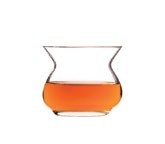Appreciating a bottle of exquisite Burgundy or rare dram of whisky demands reverence. The only way to drink either one is with proper, quality crystal glassware.


While there is no right or wrong way to drink your wine, whisky or any other spirit of your choice, there are scientifically proven ways and appropriate tools to enhance the experience. The proper glassware, especially those delicate crystal ones crafted by skilled artisans, helps develop and deliver the aroma and flavours of your liquid ambrosia.
Glassmaking dates back to at least 3,600 BC in Mesopotamia. Scholars believe the ability to create glass resulted from experiments with a mixture of silica and sand or ground quartz pebbles. Glass blowing, introduced some time in the first century, revolutionised glassmaking with techniques and tools still used today. The next big breakthrough in glassmaking came in 1674 when George Ravenscroft, an English glassmaker, developed lead glass and produced it on an industrial scale.

WHAT’S IN A GLASS
Whether for wine or for spirits, glasses come in many different shapes and sizes, the form of each provides a most technical function to the assessment of its intended beverage. As a basic reference, a typical glass has four main parts: Brim, Body, Stem, and Foot. For any type of glassware, each part carry unique qualities that help enhance the drinking experience.
WINE GLASSES
While there are now glass manufacturers who produce varietal-specific wine glasses, a universal wine glass follows a standard form and functionality. For such a vessel, clarity is of utmost importance as it allows oenophiles to assess a wine’s colour, translucency and.
MARKS OF QUALITY
This should consist of a large bottom bowl that gives room for the vino to breathe and a top that subtly curves inwards towards the rim. This allows the bouquet to be optimally bundled. The lowest portion of the bowl should form a slight, outwardly curved V-shape to help “push up” the wine – especially when it is served in a small tasting portion – so that it reaches a larger surface area of the glass to release its fragrance.
The circumference of the brim should be big enough for your entire nose to enter the glass. A good brim allows the wine to flow onto your palate without you having to move your entire head backwards. A thin rim is also essential to let the wine flow easily onto the tongue.
This provides stability and needs to be in proportion to the length of the stem and wideness of the bowl. To give it proper balance in the hand, the foot should carry a certain heft in proportion to the weight of the glass.

BRANDS TO NOTE
01 RIEDEL (PICTURED ABOVE)
Based in Austria, Riedel has been a family-owned glassware manufacturer since 1756. It pioneered the creation of wine glasses for specific wine varieties, and is a leader in educating drinkers about using proper glassware to enhance the drinking experience. Available from cmwines.com.sg.
02 ZALTO
Austrian glass manufacturer Zalto was the first to introduce highly durable, ultra-fine non-lead crystal glass blowing. Its wine glasses are delicate and elegant. The absence of lead oxide means the glass is resistant to clouding and scratches. Zalto’s Denk’Art series of bowls curve at specific angles to help wine develop optimally on the nose and the palate. Available from grandvin.com.sg.
03 GABRIEL-GLAS
Made in Austria and designed by renowned Swiss wine critic Rene Gabriel, Gabriel-Glas uses high quality, lead-free Austrian crystal glass, so its products are stronger and even more scratch- and break-resistant. Weighing just 90g, the elegant single-glass Gold Edition is mouth-blown, further increasing its resistance breakage. Available from weinvin.com.
04 SCHOTT ZWIESEL
SPIRIT GLASSES

TUMBLER

SNIFTER
BRANDS TO NOTE

WORMWOOD BY ITALESSE

GLENCAIRN WHISKY GLASS

NEAT GLASS

KIMURA GLASS


KNOWN PLEASURES
A well-made crystal glass can enhance the drinking experience. Properly shaped, a glass can concentrate desirable aromas, dissipate unwanted ones, and help aerate the liquid in your glass.
The best ones are thin and light, and their form, smooth and continuous so as to seem almost ethereal. The microscopic pores of crystal glass also help develop a beverage’s aromas when it’s swirled in crystal stemware. Crystal glasses are also good for keeping the temperature of their contents.
CARING FOR YOUR GLASSWARE


CLEANING

DRYING

STORAGE
Glasses should be stored in a well-ventilated area such as a specialty hanging glass rack. For shelves, use a soft mat to protect glasses from hard surfaces and provide air-flow for air-drying. Try not to store glasses upside down as the rim is the most fragile part of the glass and extended pressure on it might encourage chipping and/or breakage.























